What is the color temperature of light and the nuances of choosing the temperature of lamps to suit your needs
Artificial light affects people’s well-being and the comfort of staying indoors.In addition to brightness, the color temperature of the lighting device will play an important role in the perception of space - the indicator determines the shade of radiation and the priority area of use of the lamp.
This parameter should definitely be taken into account when developing the interior lighting design of an apartment, house or any other room. We will talk about how to choose a lighting device taking into account temperature and color rendering index. Our article provides recommendations for future buyers.
The content of the article:
The concept of color temperature
Color temperature (CT) characterizes the intensity of light emitted by a light bulb and determines the composition of the visible spectrum. The indicator does not indicate the amount of heat given off; its value is the visual perception of the light flux by the human eye.
However, there is a logical scientific explanation for this name.
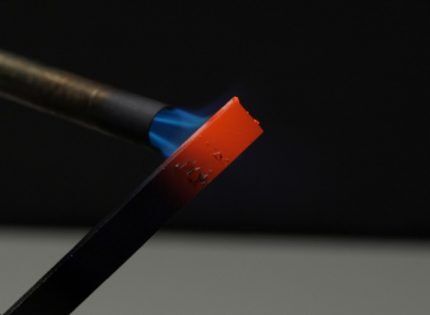
A similar analogy can be seen when assessing the glow of light sources. Incandescent lamps begin to glow at 1200 K, heating to 2000 K will give orange light, and at 3000 K - yellow. Increasing to 3500 K will cause the tungsten filament to melt.
The emission spectrum of LED crystals is different. The difference is due to different methods of origin, but the general principle is the same - obtaining the desired shade requires a certain color temperature.

Understanding CG has become relevant with the advent of various light sources. Each device is characterized by a certain range of spectral composition of radiation. Incandescent light bulbs produce a warm, yellow light.
Introduction of halogen, luminescent sources made it possible to use “cold” glow in everyday life. LED light bulbs have a wide range of light temperatures, the shade depends on the semiconductor used.
Features of color perception
In everyday life, the concept of light temperature is used when decorating interiors, selecting lamps for offices, production workshops, etc. It has been proven that a person reacts to changes in illumination - in some cases there is activation of activity, in others, on the contrary, relaxation of the body.
CT and color rendering index
The quality of lighting is greatly influenced by the color rendering coefficient - Ra or CRL. The parameter determines the ability of the light source to convey the clarity of objects, namely, the realism of the illuminated object.
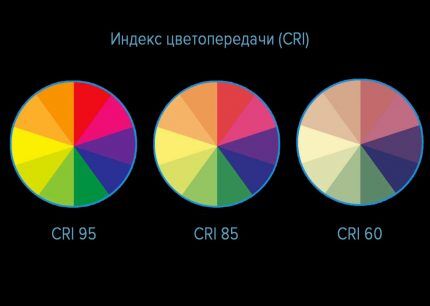
The highest color rendition of incandescent lamps and halogen lamps, the Ra parameter is 99-100.
Lighting devices with the following indicators have been used in everyday life:
- 100˃Ra˃90 – excellent light transmission properties are characteristic of fluorescent light bulbs with a five-component phosphor, LED and metal halide lamps;
- 89˃Ra˃80 – LED lamps, fluorescent devices equipped with a three-component phosphor;
- 80˃Ra – low color rendering quality; Can be used in utility rooms, corridors or for road lighting.
When choosing a lamp, it is important to consider that devices with the same light temperature can differ significantly in the quality of color rendering. Before purchasing, you should compare both parameters.

In everyday life, you should not use devices with a Ra value of less than 80. Lamps with the maximum degree of color rendering are suitable for framing and illuminating the mirror.
The influence of light on emotions
The spread of LED technologies and the variety of shapes of lamps and chandeliers make it possible not only to reduce energy costs, but also to choose a shade LED light bulbs for the functions of the room.
This aspect has a significant impact on people’s well-being, activates the brain, increases productivity, or, on the contrary, promotes rest and relaxation.
Impact of lighting on humans:
- bright warm light invigorates, helps you wake up faster in the morning, and puts you in a calm mood in the evening;
- cool shade increases concentration, but its constant exposure tires and leads to insomnia;
- intense lighting activates the body's work;
- warm colors help you rest, relax and fall asleep.
To increase living comfort and improve working conditions, dynamic solutions are being developed - lighting systems focused on human needs.
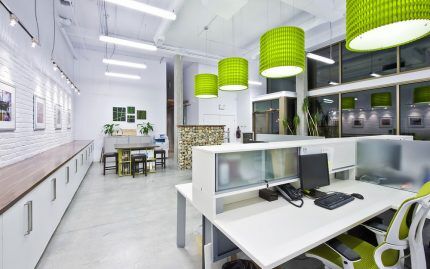
Such solutions are being implemented in European countries and the United States in the arrangement of hospitals, offices, industrial and residential premises.
The relationship between illumination and CG
Research by the Dutch physicist Kruithof (Arie Andries Kruithof) confirmed the relationship between color temperature and light intensity.
For example, a lamp with a CG index of 2700 K, emitting a luminous flux of 200 Lux, creates comfortable light. However table lamp with twice the power and the same color temperature it seems too yellow and quickly becomes annoying.

The optimal color temperature is perceived as a white glow and is close in feel to natural sunlight.
Some lighting manufacturers offer tunable fixtures. And engineers optimize light brightness and color temperature. The user independently selects the most convenient mode.
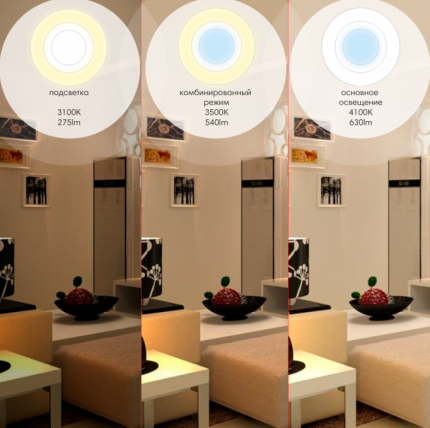
The combined version resembles daylight, has a neutral effect on a person and is suitable for everyday activities.
Temperature scale and markings
The Kelvin temperature scale clearly displays which CG indicator corresponds to the color of radiation. This gradation helps determine the type of lighting fixture.
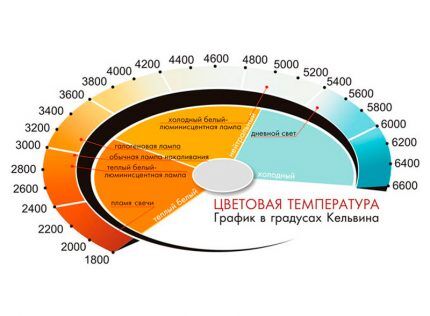
The daylight indicator fluctuates in the range of 4000-5000 K. Lamps with cold bluish shades with a CT value of 5000-6500 K are almost never used in residential premises; their main area of use is museums and jewelry stores.
The manufacturer indicates on the packaging characteristics of the lighting fixture. This rule applies to all types of light bulbs. Often brief information is duplicated on the base or radiator of the lamp itself.
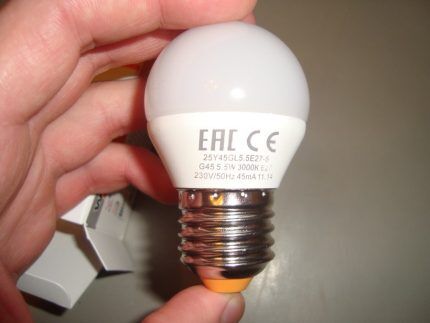
Fluorescent lamps are marked according to internationally accepted standards. The last three digits on mercury lamp – code of color rendering and color temperature.
The first marker indicates the Ra index. The number 9 corresponds to a high level of color rendering Ra = 90-100, the value 8 means that Ra is in the range of 80-89, etc.
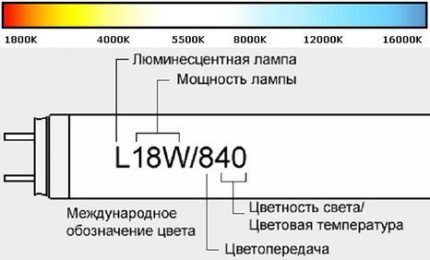
For example, 40 recommends a light color of 4000 K. Such a lamp has a neutral glow, suitable for arranging workplaces and kitchens.
DH lamps and their application
The color temperature scale is usually divided into three categories of emitted light: warm, cool and neutral. Each shade has its own effect on a person’s well-being and perception of the interior.
Group #1 - warm instrument light
The glow resembles the soft rays of the morning sun. The color temperature range is 2700-3000 K. This shade is pleasant to most people, it is not boring or irritating. This is the most familiar light, as close as possible to the rays from incandescent lamps.
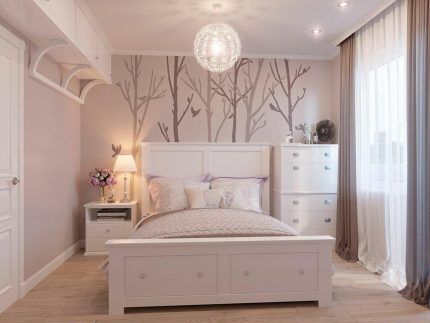
Designers skillfully use warm light to give the room an atmosphere of coziness and comfort.
The effect of glow on space is as follows:
- yellow, brown and red decorative elements look richer;
- cold tones fade somewhat - blue may fade, violet may vaguely resemble red, and turquoise may appear greenish;
- lamps are suitable for rooms decorated primarily in warm colors;
- lighting is optimal for compact rooms; in spacious apartments there may be a lack of light.
The warm shade is associated with calmness and ease. It perfectly complements home interiors. Such light is especially relevant in a space filled with wood, soft textiles, and antique products.
In public buildings, such lamps are used in beauty studios, compact boutiques, cozy cafes, and in the wards of medical institutions.
Group #2 - cool shades of lamps
Cold-type lighting is optimal for work, which is why lamps are in demand in production shops, office centers, libraries, and schools.
The CG of cold light exceeds 4500 K. The features of its indoor use are as follows:
- At home, such light should be used in doses, for example, as local desktop illumination;
- rays make gray, blue tones and other shades of the blue spectrum brighter;
- green elements can “sparkle” with an interesting emerald color;
- the perception of warm-colored objects is distorted;
- cold rays seem brighter, so they are used with caution in limited spaces, preference is given to large rooms.
Designers often use this kind of light in innovative design areas. He emphasizes the rigor of lines and constructivism, focusing on contrasts.
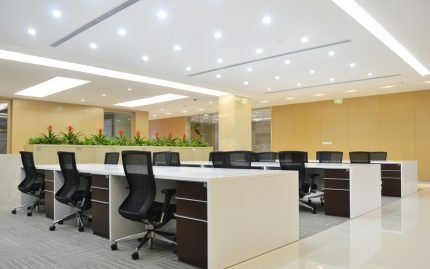
In everyday life it can be used in a dressing room or bathroom – for quick awakening. In the interior of the living room and kitchen, a cold tone is used carefully, otherwise you can get the effect of a “hospital room”.
Group #3 - neutral light bulbs
Lamps with a color range of 3200-4500 K are suitable for various rooms in the house. This could be the main lighting of the living room, hallway, children's room, dining area or kitchen.
Neutral light is indispensable near the dressing table, in the hallway - where it is customary to get dressed and create an image before going out.
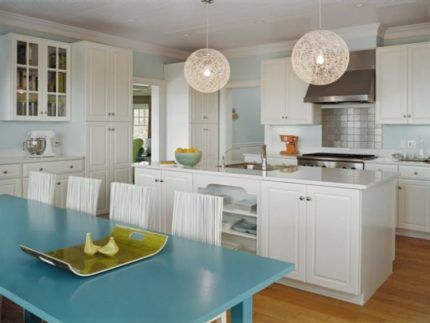
In addition to decorating living spaces, neutral-colored lamps are suitable for public buildings, classrooms, and classrooms. Neutral lighting does not create eye strain, so it is often used in offices.
Techniques for combining lamps
The combination of light sources of different glow temperatures in one room is extremely undesirable. It is not recommended to screw cold and warm colored lamps into one chandelier or use a combination of them in spot lighting of a limited space.
Despite the indicated taboo, designers identify 4 options when combining tones is possible:
- Different color temperatures are used separately in dominant and accent lighting. Spotlights of a different tone will do. This lighting is designed to highlight interior details: a beautiful painting, the texture of wall decoration, etc.
- Light zoning of space. This technique is suitable for kitchen studios and open offices. Lamps with cold, warm or neutral light are placed in separate functional areas. It is important to follow the rule of minimal contact of contrasting rays.
- A combination of warm and cold tones with universal light is acceptable.
- Implementation of lighting schemes. Project development requires a competent approach. All scenarios must be autonomous - lamps of a certain color group are turned on separately.
The last option is used most often.For example, in the bedroom the main light is made warm, and the lighting at the dressing table is neutral.

Cool lighting for photographs is provided separately. In the design of the living room, streams of light of different color temperatures do not intersect.
Conclusions and useful video on the topic
Color temperature spectrum of lighting fixtures, recommendations for choosing lamps for different rooms:
The human eye reacts to any deviations in color temperature. Changing this parameter affects performance, psychological and emotional state.
Creating a harmonious interior, arranging an office or other premises requires mandatory consideration of the shade of lamp radiation and its selection for operating conditions.
Would you like to talk about how you selected a light bulb according to the color temperature you liked? Tell us why you chose this option? Please write comments in the block below, share useful information and ask questions about the topic of the article.
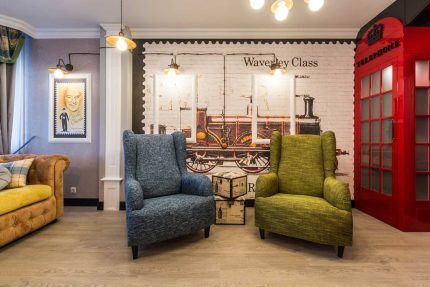




On sale, light bulbs are usually selected (among other parameters) by the type of light emitted - white or yellow. And many are afraid to choose white, thinking that it is cold. Not true! Most often, white is universal, since the stated color temperature does not exceed 4000 - 4500 K. Accordingly, they do not have a blue component, which worries many.
I don’t like yellow light because of its low-blindness, so I prefer lamps with neutral light; for warm colors, a night light or backlight (a kind of zoning).
As for the taboo on using light sources with different color temperatures in the same room (simultaneously), it is not so strict; a difference of no more than 1000 K is quite acceptable. Especially when it comes to overhead lighting.
Good afternoon, Gleb. I have to argue. The most natural light comes from incandescent lamps - their spectrum is almost 100% identical to that of the sun. White is a “mixture” of all the others.
That is, your statement that there is no “blue component” is erroneous. The low-blindness of “yellow” is explained not by less brightness, but by the property of the human eye, which processes the light flux with receptors. The latter are “tuned” by nature to the brightness of the prevailing colors of the surrounding world.
Nowadays everyone tries to depict some kind of design even in the most budget renovation, hence sometimes terrible combinations of light sources of different temperatures, and many do not even bother with such a topic as light temperature. Like, it’s shining, and that’s okay. Whichever light bulb was on sale was the one we took. And from the beginning of the 2000s, I remember an article in one medical journal, where it was said in plain text: the most natural light for the human eye is warm yellow. Or at least close to it.
Therefore, in my house a categorical “NO” is said to cold light bulbs, and “YES” to neutral ones, but to a limited extent, exclusively in the “business” areas of the house (hallway, living room, bathroom).To prevent a yellow lamp from turning yellow so that everything around seems distorted and unpleasant, you just need to take a more powerful lamp, then the colors of the surrounding things practically do not change.
Good afternoon, Igor. I will repeat the advice of Professor Preobrazhensky from “Heart of a Dog”, adapted for modern times - do not read the Internet, newspapers, magazines. Let me explain - a medical publication that claims that warm yellow light is the most natural is lying a little.
The visual analyzers of the creatures inhabiting our Earth were formed by sunlight. This one is the most natural. And one more thing - energy-saving lamps pay for themselves in rooms where they are used for a long time. The toilet and bathroom are not like that.
Hello Vasily. Please tell me if light with a color temperature of 4000k is suitable for 8-12 hours of work at the computer, provided that I am a bespectacled person. If not, why not and what do you recommend? Thank you.
The color temperature also depends on the wall lamps